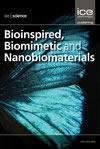骨组织工程用羧甲基纤维素基复合材料的研究进展
IF 0.6
4区 工程技术
Q4 ENGINEERING, BIOMEDICAL
引用次数: 0
摘要
本研究的重点是通过冻干工艺制备羧甲基纤维素(CMC) -双相磷酸钙(BCP)复合支架,用于骨组织工程。在CMC中加入柠檬酸或富马酸作为交联剂,提高复合支架的稳定性。研究了冻结温度(- 20、- 40或- 80℃)对复合材料支架孔隙形态、膨胀能力和力学性能的影响。与非交联支架相比,交联支架的热降解温度更高。复合支架均呈现CMC与BCP均匀共混的多孔结构。交联支架在磷酸盐缓冲盐水中表现出明显的溶胀能力和稳定性,而非交联支架在24 h内不稳定。在干燥条件下,交联支架的抗压强度低于非交联支架。然而,在水合状态下,只有柠檬酸交联支架在- 20、- 40和- 80℃处理时稳定,抗压强度分别提高了64±4、57±4和67±4 kPa。此外,在柠檬酸交联支架上三维培养Saos-2细胞表明其具有细胞增殖和成骨分化的能力。因此,柠檬酸交联CMC-BCP复合支架在骨组织工程中有很好的应用前景。本文章由计算机程序翻译,如有差异,请以英文原文为准。
Development of carboxymethylcellulose based composites for bone tissue engineering
The present study focuses on the development of carboxymethylcellulose (CMC)–biphasic calcium phosphate (BCP) composite scaffolds through the freeze-drying process for bone tissue engineering applications. Citric acid or fumaric acid was added as the cross-linker of CMC to improve the stability of composite scaffolds. The effect of change in freezing temperature (−20, −40 or −80°C) on the pore morphology, swelling ability and mechanical properties of composite scaffolds was studied. Cross-linked scaffolds showed an increased thermal degradation temperature compared with non-cross-linked scaffolds. All the composite scaffolds showed a porous structure with homogeneous blending of CMC and BCP. Cross-linked scaffolds showed appreciable swelling ability and stability in phosphate-buffered saline, while non-cross-linked scaffolds were unstable for 24 h. Cross-linked scaffolds had lower compressive strength than non-cross-linked scaffolds under dry conditions. However, in the hydrated state, only citric acid-cross-linked scaffolds were stable with improved compressive strength of 64 ± 4, 57 ± 4 and 67 ± 4 kPa when processed at −20, −40 and −80°C, respectively. Furthermore, three-dimensional culture of Saos-2 cells on citric acid-cross-linked scaffolds showed their suitability for cell proliferation and osteogenic differentiation. Therefore, citric acid-cross-linked CMC–BCP composite scaffolds may be promising scaffolds for bone tissue engineering applications.
求助全文
通过发布文献求助,成功后即可免费获取论文全文。
去求助
来源期刊

Bioinspired Biomimetic and Nanobiomaterials
ENGINEERING, BIOMEDICAL-MATERIALS SCIENCE, BIOMATERIALS
CiteScore
2.20
自引率
0.00%
发文量
12
期刊介绍:
Bioinspired, biomimetic and nanobiomaterials are emerging as the most promising area of research within the area of biological materials science and engineering. The technological significance of this area is immense for applications as diverse as tissue engineering and drug delivery biosystems to biomimicked sensors and optical devices.
Bioinspired, Biomimetic and Nanobiomaterials provides a unique scholarly forum for discussion and reporting of structure sensitive functional properties of nature inspired materials.
 求助内容:
求助内容: 应助结果提醒方式:
应助结果提醒方式:


